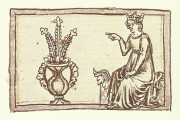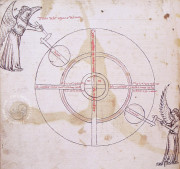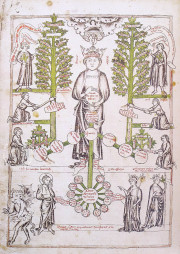Created in Catalonia, likely at Girona or Lleida, at the end of the fourteenth century, the Madrid Breviari d'amor is a stunning example of book production. Its text was read for edification and entertainment across the culturally connected regions of southern France and northern Spain. The manuscript's nearly 180 images are drawings in ink with delicate shading, a technique popular in the late Middle Ages to demonstrate artistic skill through an economy of form.
The Breviari d'amor ("brief summa of love") is a lengthy compendium of all available knowledge, divided into three branches of thought: natural philosophy, Christian doctrine, and the ethics of courtly love.
A Picture Encyclopedia
Unlike most encyclopedic literature of its time, the Madrid manuscript has an ambitious visual program: eleven stunning diagrams pertaining to natural philosophy and a genealogical table are joined by an extensive array of Old and New Testament scenes and other illustrations.
Captivating Diagrams
The "Tree of Love" features a female personification of Love presenting a schematic tree of knowledge divided into branches (fol. 3v). Other diagrammatic images depict aspects of astronomy, astrology, meteorology, gemology, and more. They frequently include creative details such as angels using cranks to turn the cosmos (fol. 24v).
The Bible Illustrated
The biblical illustrations also include unusual details, such as the hand of God emerging from an arc of heaven and grasping Moses by the hair as he observes the bush that remains unconsumed by fire (fol. 72v). In the illustration of the Women at the Tomb, one of the women reaches into the sarcophagus to lift the empty shroud (fol. 197v).
Love as a Key Concept
The text of the Breviari was initially written in verse by Matfre Ermengaud in Occitan, the dialect of southern France, in the late thirteenth century. The Madrid manuscript is one of five surviving copies of his text translated into Catalan prose.
Ermengaud draws his diverse topics together by intertwining the concept of love in aspects of medieval thought, namely, cosmic, theological, and courtly love. Created in response to the Latin encyclopedias produced in Paris, Oxford, and elsewhere, the Breviari shows regional character through its defense of courtly love.
A Reader-Friendly Text
The text is compact and legible. It is written in two columns in a Gothic Hybrida script featuring dramatic ascenders and descenders and with frequent abbreviations. Certain features of the presentation—especially the section headings and picture captions in red—aid the reader in using the encyclopedia as a reference book.
The Mysterious Origin of a Popular Book
The manuscript's ownership is unknown until Gaspar Galcerán, Count of Guimerá, purchased it in 1635 after it had changed hands several times, the first known occurrence in Valencia in 1426.
We have 1 facsimile edition of the manuscript "Madrid Breviari d'Amor": Breviari d'Amor facsimile edition, published by Vicent Garcia Editores, 1980
Request Info / Price














